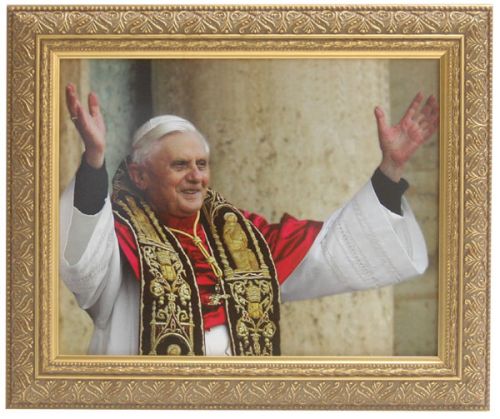 The cover of Time this week features a large image of Pope Benedict XVI with an American flag in the background. As I will try to show later, this is ironic, but for now it's worth noting that the cover story is "Why the Pope Loves America."
The gist of the article is that the pontiff admires the American form of government and its diverse, religiously minded citizens:
The cover of Time this week features a large image of Pope Benedict XVI with an American flag in the background. As I will try to show later, this is ironic, but for now it's worth noting that the cover story is "Why the Pope Loves America."
The gist of the article is that the pontiff admires the American form of government and its diverse, religiously minded citizens:
[H]e entertains a recurring vision of an America we sometimes lose sight of: an optimistic and diverse but essentially pious society in which faiths and a faith-based conversation on social issues are kept vital by the Founding Fathers' decision to separate church and state. It's not a stretch to say the Pope sees in the U.S.--or in some kind of idealized version of it--a civic model and even an inspiration to his native Europe, whose Muslim immigrants raise the question of religious and political coexistence in the starkest terms.
Benedict, the story notes, shows his appreciation for America in many ways: He has appointed American prelates as his No. 1 and No. 3 officials in his office at the Vatican; he enjoys the frankness and intellectual independence of the United States bishops' doctrinal office; and above all, he likes Americans' notion of the importance of peaceful coexistence.
The story is true. It's also besides the point.
Bono isn't touring the United States next week; Pope Benedict XVI is. Reporters David Van Biema and Jeff Israely elevated a minor element of Benedict's pontificate to the status of a major one.
Yes, the story acknowledges that Benedict is concerned about moral relativism and secularization in American life. But the reporters treat this as a side issue. Their emphasis is misplaced, and not just because one of Benedict's key messages is that a "dictatorship of relativism" threatens Western civilization.
As my friend Dan Kearns points out, a second theme of Benedict is that Christianity offers "consolation, hope, and joy in a seemingly dark universe." His first encylicals are titled "God is Love" (Deus Caritas) and "Hope" (Spe Salvi). The theme of his visit is "Christ Our Hope." Consider, too, his recent announcement about the purpose of his visit to America:
"Following in the footsteps of my venerable predecessors, Paul VI and John Paul II, I shall come to United States of America as Pope for the first time, to proclaim this great truth: Jesus Christ is hope for men and women of every language, race, culture and social condition," he said. "Yes, Christ is the face of God present among us.
"Through him, our lives reach fullness, and together, both as individuals and peoples, we can become a family united by fraternal love, according to the eternal plan of God the Father.
"I know how deeply rooted this Gospel message is in your country. I am coming to share it with you, in a series of celebrations and gatherings. I shall also bring the message of Christian hope to the great Assembly of the United Nations, to the representatives of all the peoples of the world."
Van Biema and Israely miss this central message of Benedict's pontificate. Instead of summarizing and critiquing this theological view, the reporters emphasize his political philosophy:
This Pope, more a student of global drama than an eager protagonist, knows that rising religious conflict may be the 21st century's great challenge. He also appears to sense that American power alone won't solve it--but that the power of American values still might. In rummaging through our founding precepts for a path for his own purposes, he might find something important for us to remember too.
Why the reporters missed the real story about Benedict is difficult to say. They read through many of his writings and talked to various sources. All I would recommend is that reporters covering the Pope's visit read Zenit.org, a Web site about the Vatican. It contains all of his public sermons, speeches, and documents. As such, the site is the best first-hand account of his thinking and message.
The staff at Time should read the site. If they had done so, the cover no doubt would have been more accurate: a big picture of the Pope and a cross or crucifix, with an American flag in the distant background.
